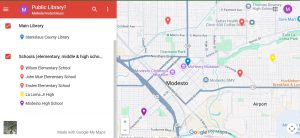International libraries such as the Oodi Central Library in Finland is on the top of my list of envy inducing FOMO (Fear of Missing Out). Having lived in the Central Valley of California I have come to assume that when “central” is used it is applied broadly and without geographic merit like real estate listings that are loosely adjacent to prime properties as being “emerging markets.” Oddi is legitimately central to greater Helsinki and falls within a ten-minute walk to public transport stations (Google, n.d.). Locally my nearest branch is five miles away with a ten-minute drive, with three other branches within a ten-mile circumference. Public transportation to the four branches I frequent are not amenable to a central description as each of the four require a minimum of fifty-five minutes to an hour twenty depending on the day of the week and time with at a minimum of a half an hour of walking to the nearest bus stop.
The greater distance you live away from the old town center, the greater cost and time commitment necessary for access to a shared community space. Finland is diametrically opposite having established for each village a school and library since the 1800’s (Cord, 2018). Where I live it requires planning to visit a branch, either by private vehicle or public transport. Many international libraries do not have a transportation barrier to library access, with some locations even allowing for adolescents to drop by every day (Lauresen, 2019). Nordic countries are renown for high literacy rates and happiness compared to other countries. I live in a county with low literacy rates and restrictive transportation to libraries. It makes me consider the correlation between literacy rates, happiness and access to community spaces that should be accessible to all members of a community. The My Maps below, amplifies the issue with access to younger members of our community. The listed schools are within a one to two mile distance from a public library with public transport routes. Almost all require crossing of busy intersections, state roads or state highways belying the perception of safe, public accessibility.
In a very unscientific application of the nearby function on Google Maps, I have greater access to bars and sporting goods stores using private and public transportation. If library closures are based on circulation and visits, then transportation access should also factor into the algorithm particularly if new branch construction is off the table.
 Stanislaus County Library and Nearby Schools. My Maps.
Stanislaus County Library and Nearby Schools. My Maps.
Cord, D.J. (2018). Helsinki invests in its people with a library that reinvents the genre. This is Finland. https://finland.fi/life-society/helsinki-invests-in-its-people-with-a-library-that-reinvents-the-genre/?fbclid=IwAR02YiMMaUOXanedOfFbDrzhou_4s1_oHQInvzYDk3bPJeu9Vx3D_ItX5Zs
Google. (n.d.). [Oodi Central Library and nearby public transport stations]. Retrieved July 19, 2025, from https://www.google.com/maps/search/public+transport+station/@60.1736828,24.9275925,1201m/data=!3m2!1e3!4b1!4m8!2m7!3m6!1spublic+transport+station!2sHelsinki+Central+Library+Oodi,+T%C3%B6%C3%B6l%C3%B6nlahdenkatu+4,+00100+Helsinki,+Finland!3s0x46920bcab6fcbbeb:0x6edaf369263e75dd!4m2!1d24.9379191!2d60.1736833?entry=ttu&g_ep=EgoyMDI1MDcxNi4wIKXMDSoASAFQAw%3D%3D.
Lauersen, C. (2021, April 19). Impact of public libraries in Denmark: A haven. https://christianlauersen.net/2021/04/19/a-haven-in-our-community-the-impact-and-value-of-public-libraries/

Fascinating exploration of barriers to access! I live in a rural area where towns are small and spread out. I’m lucky to have a library about a five minute drive from me, but smaller and more remote town aren’t so lucky. Because of this, I’ve focused a lot on mobile services like bookmobiles that can bring information and technology to people who wouldn’t otherwise have access. I haven’t looked into Oodi (though it’s now on my list of international libraries I definitely need to visit!), but I wonder if they have or need similar mobile services, or if their transportation and social infrastructure are already enough to support their communities. Thought-provoking blog and factors to consider for library advocacy! Kudos!
@gneissterran This post really resonates with me and my feelings for public transportation!! I also live in an area where libraries are not quite as accessible as they might be in some other places. I often envy my friends who live in larger cities with great public transportation infrastructure. I do wish it were more of a focus in the U.S. in the way that it is in a lot of European countries. I think you’re definitely on to something with considering a correlation between literacy rates and access to community centers/libraries. I like the idea of having adequate transportation in place prior to building a new branch/selecting a new branch location, or at the very least, ensuring that some funding could be acquired for a Book Mobile or other library vehicle to reach folks who might not live in areas with access to decent public transportation!